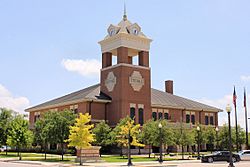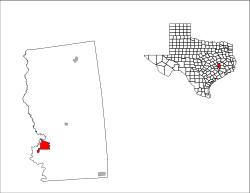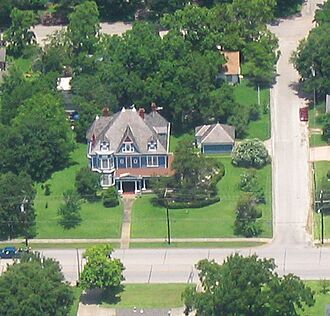Navasota, Texas facts for kids
Quick facts for kids
Navasota, Texas
|
|
|---|---|

Navasota City Hall
|
|
| Nickname(s):
The Blues Capital of Texas
|
|

Location of Navasota, Texas
|
|
| Country | United States |
| State | Texas |
| Counties | Brazos, Grimes |
| Area | |
| • Total | 8.37 sq mi (21.67 km2) |
| • Land | 8.33 sq mi (21.57 km2) |
| • Water | 0.04 sq mi (0.10 km2) |
| Elevation | 213 ft (65 m) |
| Population
(2020)
|
|
| • Total | 7,643 |
| • Estimate
(2023)
|
9,027 |
| • Density | 913.1/sq mi (352.70/km2) |
| Time zone | UTC-6 (Central (CST)) |
| • Summer (DST) | UTC-5 (CDT) |
| ZIP code |
77868, 77869
|
| FIPS code | 48-50472 |
| GNIS feature ID | 2411217 |
Navasota is a city mostly in Grimes County, Texas, United States. A small part of the city is also in Brazos County. In 2020, about 7,643 people lived here.
Navasota is known as the "Blues Capital of Texas." This special title was given in 2005 by the Texas Legislature. It honors Mance Lipscomb, a famous blues musician who was born in Navasota.
Contents
Navasota is located in the southwestern part of Grimes County. It sits east of the Navasota River, which flows into the Brazos River.
Texas State Highway 6 runs along the eastern side of the city. It can take you northwest about 22 miles (35 km) to College Station. Or, you can go south about 21 miles (34 km) to Hempstead.
Texas State Highway 105 goes through the center of Navasota. This highway leads southwest about 25 miles (40 km) to Brenham. It also goes east about 41 miles (66 km) to Conroe. The big city of Houston is about 71 miles (114 km) southeast of Navasota.
The city covers a total area of about 8.37 square miles (21.67 km2). Most of this area is land, with only a small amount of water.
Navasota began in 1831 as a stop for stagecoaches. It was first called "Nolansville." In 1858, its name changed to Navasota. This name might come from a Native American word, nabatoto, which means "muddy water."
In September 1859, the Houston and Texas Central Railway built tracks into the town. This made Navasota a very important place for shipping goods. Nearby Washington-on-the-Brazos was once a key town. But when it didn't want the railroad, many businesses moved to Navasota.
During the American Civil War, Navasota was a busy hub for the Confederacy. Goods like cotton, gunpowder, and shoes were made and stored here. By 1865, about 2,700 people lived in Navasota. All the goods from the region came to Navasota. It was the furthest inland train stop in Texas. From here, goods were sent to Galveston. They could then go by steamboat up the Mississippi River or be shipped overseas.
Tough Times and Rebuilding
Navasota faced several big problems in the mid-1860s. In 1865, a warehouse full of cotton and gunpowder exploded. This happened after some soldiers set it on fire. The explosion killed many people and destroyed much of the downtown area.
After that, a deadly cholera sickness hit the town. Then, in 1867, an even worse yellow fever epidemic spread. Many people, including the mayor, left Navasota to escape the diseases. The town's population dropped by about half.
In the late 1860s, Navasota was known as a very wild place. It was so rough that women and children were often told not to go downtown. There were many saloons and gaming halls. Every Sunday morning, the undertaker would go downtown to pick up bodies after a wild Saturday night.
Marshal Frank Hamer
By 1908, Navasota was still a "Wild West" town. There were so many shootouts that over a hundred men died in just two years. That's when Frank Hamer, a famous lawman, was hired. He was only 24 years old and came from the Texas Rangers.
Hamer became the City Marshal. He worked hard to bring law and order to Navasota. He arrested criminals until the streets became safe again. He served as marshal until 1911.
Frank Hamer became even more famous later. In 1934, he led the group that found and shot Bonnie and Clyde. In 2012, Navasota honored him with a statue. It stands in front of the city hall building.
Navasota continues to grow and improve. In 2018, the city had an estimated population of 7,715 people. The city has 23 industrial companies, providing over 1,200 jobs.
In 2009, Navasota was chosen as a "Visionaries in Preservation" city. This means the Texas Historical Commission recognized its efforts to protect its many old, important buildings. A new city hall was finished in 2011. Improvements to the downtown area are still happening.
The Navasota Municipal Airport finished making its runway longer in 2012. It is now 5,000 feet (1,524 m) long and 75 feet (23 m) wide. This means it can now handle jet planes.
In 2011 and 2013, Navasota received a Gold Leadership Award. This award is from the Texas Comptroller's Office. It recognizes cities that are very open about their government activities.
In 2012, the Union Pacific Railroad named Navasota "Train Town USA." In 2013, the Texas Department of Agriculture named Navasota a "Certified Retirement Community." This means it's a great place for older adults to live.
Navasota has its own local newspaper, the Navasota Examiner. This paper has been reporting news from Grimes County since 1894.
The city also has two radio stations: Willy 98.7 FM and 1550 AM. These stations play classic country music. They also share local news and broadcast live football games for the Navasota Rattlers team.
Navasota's historic downtown area is full of interesting shops. You can find antique stores, gift shops, and art galleries. Many of these are in beautiful old stone and brick buildings.
Live plays are often performed at the Sunny Furman Theatre. The city also has places for golf and several parks. You can also visit local wineries.
Many historic Victorian homes can be seen on Washington Avenue. This is the main street for homes and businesses in town.
Another cool place is Brule Field. This is a natural amphitheater built in the 1930s from local stone. It used to be the main field for the Navasota Rattlers high school football team. Many old churches made of native stone are also near downtown.
Navasota has two statues of the French explorer René-Robert Cavelier, Sieur de La Salle. One is a bronze monument from 1936. It celebrates his travels. The other is a stone bust. It was given to the city by the French government in 1978. It is now at August Horst Park.
Every spring, Navasota is a popular spot to see bluebonnets. These are the state flower of Texas. You can also visit Mance Lipscomb Park, which has a statue of the blues musician. The statue of Frank Hamer stands in front of city hall. It honors his time as city marshal.
Other attractions include art galleries and places to enjoy live music. There are also food truck parks and several murals perfect for taking photos. Seasonal festivals bring many people to Navasota each year, often featuring live music.
Navasota has grown quite a bit over the years. Here's how the population has changed:
| Historical population | |||
|---|---|---|---|
| Census | Pop. | %± | |
| 1870 | 1,509 | — | |
| 1880 | 1,611 | 6.8% | |
| 1890 | 2,997 | 86.0% | |
| 1900 | 3,857 | 28.7% | |
| 1910 | 3,284 | −14.9% | |
| 1920 | 5,060 | 54.1% | |
| 1930 | 5,128 | 1.3% | |
| 1940 | 6,138 | 19.7% | |
| 1950 | 5,188 | −15.5% | |
| 1960 | 4,937 | −4.8% | |
| 1970 | 5,111 | 3.5% | |
| 1980 | 5,971 | 16.8% | |
| 1990 | 6,296 | 5.4% | |
| 2000 | 6,789 | 7.8% | |
| 2010 | 7,049 | 3.8% | |
| 2020 | 7,643 | 8.4% | |
| U.S. Decennial Census | |||
In 2020, Navasota had 7,643 people. There were 2,661 households and 2,011 families living in the city.
In 2010, the city had 7,049 people. About 37% of households had children under 18. The average household had 2.81 people.
The median age in Navasota was 32.9 years. About 30.7% of the population was under 18.
The Navasota Independent School District (NISD) serves the students in Navasota. It has five regular schools and one alternative school. All the schools met the standards set by the Texas Education Agency.
Navasota High School is recognized for its English/Reading programs. It also does well in student progress and preparing students for college. Navasota Junior High and the elementary schools also show strong student progress. High Point Elementary is especially good in several areas, including math and closing learning gaps.
NISD offers many programs to help students learn. These include classes for gifted students and college-level courses. They also have support for students with dyslexia and those learning English. Special services are available for students with various needs.
The average class size is small, with about 14 students per teacher.
Students can join many school groups and sports. Some popular choices include:
- Sports: Football, Volleyball, Cross Country, Basketball, Golf, Tennis, Baseball, Softball, Powerlifting, Soccer, and Track.
- Clubs: Business Professionals of America, FFA, Student Council, National Honor Society, Theatre, Choir, Band, and Spanish Club.
The Navasota High School boys basketball team won the state championship in 1990. They had a perfect record of 35 wins and 0 losses. The Navasota Rattlers football team also won state championships in 2012 and 2014.
Many interesting people have connections to Navasota:
- Alvin Ailey – A famous dancer and choreographer.
- Kathleen Blackshear – An artist.
- Clay Condrey – A Major League baseball pitcher.
- Frank Hamer – A city marshal and Texas Ranger, known for his law enforcement work.
- Mance Lipscomb – A well-known blues singer.
- R. Bowen Loftin – A former president of Texas A&M University who graduated from Navasota High School.
- Chuck Norris – A martial artist and actor.
- Robert Reed – An actor, famous for playing the dad on The Brady Bunch.
- Joe Tex – A soul musician.
Images for kids
See also
 In Spanish: Navasota (Texas) para niños
In Spanish: Navasota (Texas) para niños














